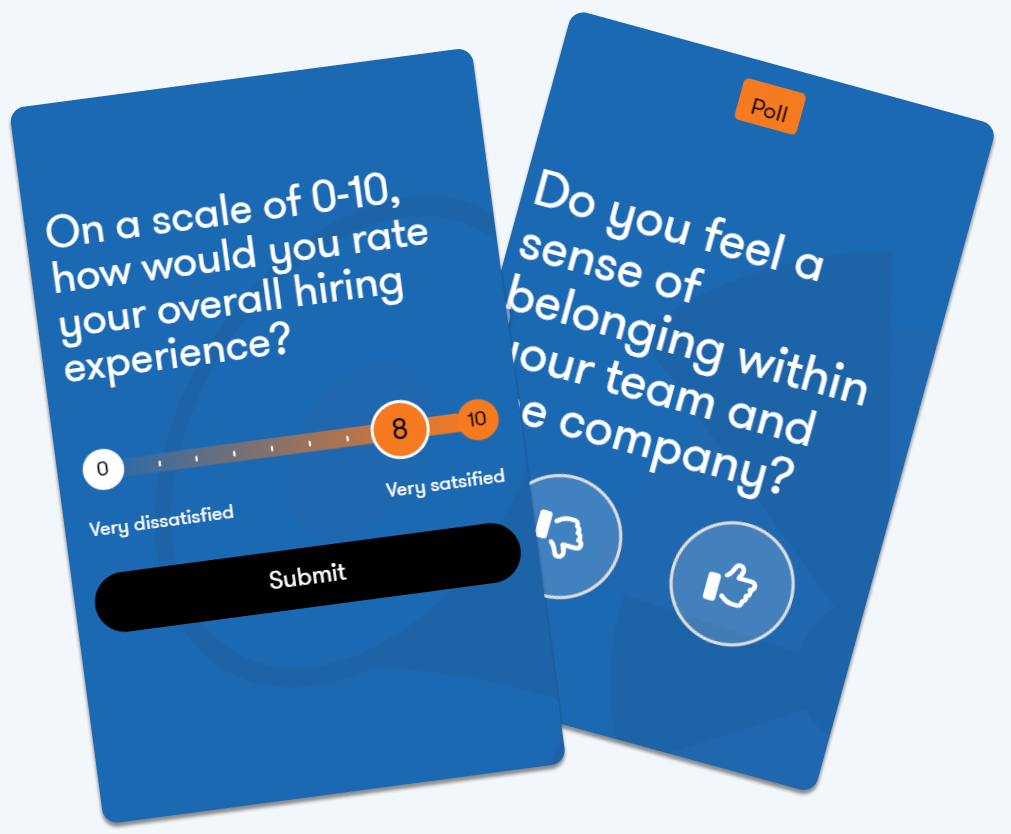A solid employee onboarding experience isn’t something you can throw together and cross your fingers that everything goes well. It needs to be intentional and always evolving to meet the needs of your workforce.
A key part of a strong onboarding process is asking intentional questions in your onboarding survey. Knowing what to ask, when to ask it, and what to do with the collected data are the keys to success for your program.
According to a survey conducted by Brandon Hall, organizations that implement a robust onboarding process witness a remarkable 82% improvement in employee retention. In this post, we’ll uncover the secrets behind this astonishing statistic as we explore the transformative power of onboarding surveys.
What is an onboarding survey?
An onboarding survey is a series of questions that companies ask new hires to respond to for the purpose of gathering feedback and evaluating the effectiveness of their hiring and onboarding processes.
No matter the role you’ve hired for and how experienced your new hire is, starting a new job can be stressful and overwhelming. Having a well-thought-out and executed onboarding program goes a long way in helping your new hire feel comfortable and confident in their ability to perform well in their new role. By incorporating onboarding surveys with strategic timing and intentional questions, you’ll show your employees that your company cares about what they have to say.
The questions you ask can go back to when they first heard about the company through the hiring process and the initial time spent on the job.
Employee surveys are a critical part of your employee feedback strategy. You can find out if you are setting your employees up for success.
Surveys are beneficial in that you have a quick and efficient way to check in. They benefit the employee in that they know you value their voice. What they have to say matters.
Examples of new hire onboarding survey questions
Onboarding survey questions serve multiple purposes.
First and foremost, you’re asking the employee for their feedback.
Second, you’re inevitably communicating what you think is important through the questions asked. This helps establish a culture where feedback is valued and is a part of the employee experience. And of course, your survey serves the purpose of providing tangible data to management about how they should improve hiring and onboarding processes.
In order to get a full picture of how the onboarding process is going, it’s best to collect survey answers in two phases.
Phase one focuses on questions about recruitment and the onboarding experience. These should be in a survey given around the first week mark of employment.
Phase two includes questions about engagement, alignment, and circles back to onboarding for anything missed. Include these questions in a survey given around the 30th day of employment.
You can and should use different question types, but keep in mind you’ll likely get the most value out of open-ended questions, so be sure to include plenty of them.
Phase one onboarding questions to ask your new hire:
1. What factors initially attracted you to our company?
2. On a scale of 1-5, how would you rate your overall hiring experience?
3. Was the information you were provided with about our onboarding process clear before your first day? Do you have any suggestions for improvement?
4. On a scale of 1-5, how would you rate your communication with our hiring team during the interview process?
5. Did you feel well-prepared for your first day at work? If not, what would have helped?
6. Which of our company’s culture and values did you feel stood out when going through the hiring process?
7. Were there any specific factors that influenced your decision to accept this job?
8. On a scale of 1-5, how satisfied are you with the support you received during your initial onboarding?
9. What has been the most positive part of your onboarding experience so far?
10. What suggestions do you have that would help us improve the onboarding experience?
Phase two onboarding questions to ask your new hire:
1. Do you feel a sense of belonging within your team and the company?
2. On a scale of 1-5, how aligned do you feel with the company’s mission, vision, and values?
3. Do you feel that you received the support and resources you need to perform your job so far? If not, please share your thoughts on what you feel is missing.
4. Do you feel that you have a clear understanding of your role and responsibilities?
5. On a scale of 1-5, how well do your day to day responsibilities match the expectations you had when you accepted your job offer?
6. On a scale of 1-5, how satisfied are you with the level of communication and feedback you’ve received?
7. Do you feel your contributions are valued and recognized within your team?
8. Have you had the chance to collaborate and build relationships with colleagues across different teams?
9. Have you been introduced to the available employee support programs and resources (e.g., mentoring, wellness initiatives)?
10. On a scale of 1-5, how engaged do you feel in your role?
These questions will help gauge the new hire’s sense of belonging, alignment with the organization, and level of engagement. You should adapt these questions as needed to align with your organization’s specific goals.
What are the benefits of employee onboarding surveys?
Collecting onboarding surveys opens up a world of insights. It reveals what’s hitting the mark and what needs improvement. You’ll uncover hidden gems that significantly impact engagement, often with surprising factors you might not have realized were influential.
The benefits of a stellar onboarding survey extend to several critical employee experience and engagement key performance indicators (KPIs).
Boosting retention
A positive onboarding experience sets the stage for increased employee retention. When new hires feel supported and welcomed, they’re more likely to stick around for the long haul. You can quantify this by calculating your employee retention rate.
Speeding up time to productivity
The effectiveness of your onboarding process directly impacts how quickly new employees become productive contributors. A well-structured onboarding program helps flatten their learning curve, enabling them to deliver valuable work to the company sooner.
Increasing employee referral rate
Have more roles that you need to hire for? When new hires have a positive introduction to your organization, they’re more inclined to recommend you as an exceptional place to work. This can lead to referrals of top-tier talent, enriching your talent pool.
Additionally, you may experience more benefits such as:
Improving onboarding
By collecting valuable feedback through onboarding surveys, you gain a deeper understanding of what’s working effectively and what’s not. Armed with this knowledge, you can make targeted changes creating a smoother and more impactful onboarding experience for new hires.
Gauging employee engagement from the start
By asking thoughtful questions, you can assess how engaged new hires feel during the onboarding process, whether they are enthusiastic about their role, and if they perceive themselves as a valuable part of the organization. This early measurement of engagement sets the stage for continued growth and alignment.
Strengthening first impressions
By seeking feedback from new hires, you can identify aspects that contribute to a positive first impression, such as clear communication, a welcoming environment, and effective training. Armed with this information, you ensure that new employees feel valued, supported, and excited about their journey with your company.
Create and share mobile onboarding surveys in minutes

Best practices for your onboarding questionnaire
1. Your surveys should evolve over time
Your onboarding survey isn’t the type of thing that you should write once and never touch again. Just as your business evolves, so will your questionnaire. Its purpose is to meet the needs of your people and business over time.
2. Consider your surveys’ timing
Consider when you want to send your surveys. Timing matters. It could be directly after onboarding, after 30 days in a role, and after a new training session.
3. Look for patterns in responses
After collecting the surveys look for patterns in the responses. Interpreting data for those that have left within a year and those who have stayed will provide important insights.
4. Make surveys easy and convenient to complete
Getting feedback from as many people, if not everyone, is critically important to obtaining reliable results from your surveys. Just like when people review their favorite restaurants, the people who tend to leave reviews on their own are either very satisfied, or very dissatisfied with their experience. These two extremes polarize results and can easily skew your data to give you the wrong impression (in either direction).
By delivering your survey via a mobile training platform, it fits right in with your employees’ existing training materials and resources, and takes just a few minutes to complete. Your mobile training platform also gathers the results in a format that is easy to review and analyze to cut down on your admin work.
The importance of responding to employee onboarding survey results
Now that you’ve collected survey responses, it’s time to act. You’ve taken the first steps in showing your staff that you care about what they have to say, so don’t stop there.
According to research conducted by Qualtrics, 60% of U.S. employees have a way to provide feedback about their employee experience. However, a mere 30% of U.S. employees feel that their feedback is actually taken into consideration by their employers. When it comes to surveying your new employees, you must value their time and feedback.
Take into account what they’ve shared and make adjustments. Having a complete onboarding process will lead to higher employee satisfaction and stronger company outcomes.
Gather feedback from your employees, without interrupting the work day.

FAQs
What questions should I ask in an onboarding survey?
Your onboarding survey questions should cover topics such as how the employee felt about the onboarding process, role clarity, team integration, support and resources, and manager support and feedback. Here are some basic questions to help you get started:
- On a scale of 1-5, how would you rate your overall hiring experience?
- Was the information you were provided with about our onboarding process clear before your first day? Do you have any suggestions for improvement?
- On a scale of 1-5, how would you rate your communication with our hiring team during the interview process?
- Did you feel well-prepared for your first day at work? If not, what would have helped?
What are the 4 phases of onboarding?
The four phases of onboarding are: preboarding, onboarding, training, and transition to the new role.
What questions are asked in a 7-day onboarding survey?
The first week of employment is a great time to ask about the initial impression of the company and onboarding experience. Here are some examples:
- On a scale of 1-5, how would you rate your overall hiring experience?
- Do you feel that you have a clear understanding of your role and responsibilities?
- On a scale of 1-5, how satisfied are you with the support you received during your initial onboarding?
What are the 5 Cs of onboarding?
The 5 Cs of onboarding are: compliance, clarification, confidence, connection, and culture.
Value what your staff has to say
After surveying 900 onboarding managers, TalentCards found that 72% of surveyed companies have unfilled positions due to insufficient qualified workers. This staggering statistic highlights the importance of retaining new talent when you hire them.
Implementing a post-onboarding survey is one way to improve your new hire experience. Let them know that their voice matters, consider any adjustments that should be made, and keep the lines of communication open.
You’ve found the right person for the job. Now it’s time to keep them engaged and let them shine!
Key takeaways
- A solid employee onboarding experience requires intentionality and constant evolution to meet the needs of your workforce.
- Asking strategic and intentional questions in your onboarding survey is crucial for the success of your program. It is key to know what to ask, when, and how to utilize the collected data.
- Organizations that implement a robust onboarding process witness an impressive 82% improvement in employee retention, according to research. Onboarding surveys play a pivotal role in uncovering the secrets behind this statistic and harnessing the transformative power of feedback.
- Onboarding surveys should cover various aspects of the employee experience, starting from the recruitment process to initial job experiences. Incorporating open-ended questions allows employees to express themselves fully and provides valuable insights.
- Effective onboarding surveys offer numerous benefits:
– Improved onboarding
– Measurement of employee engagement
– Strengthening first impressions
– Increased retention
– Accelerated time to productivity
– Higher employee referral rates
– Fostering a feedback-driven culture


